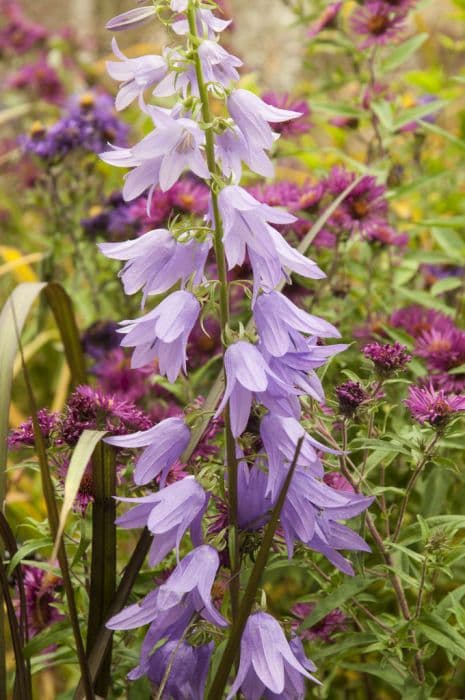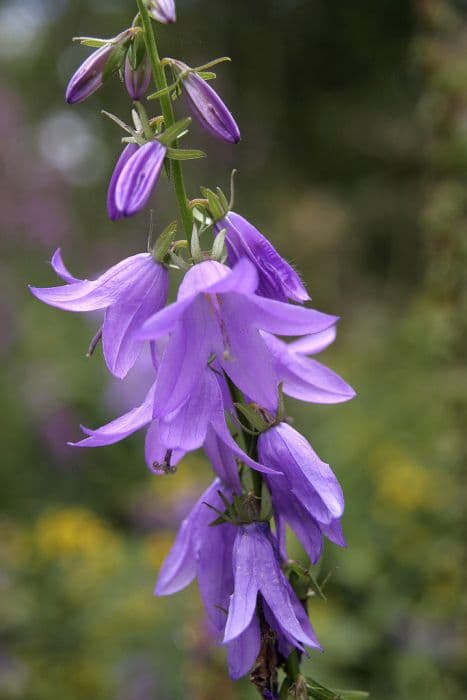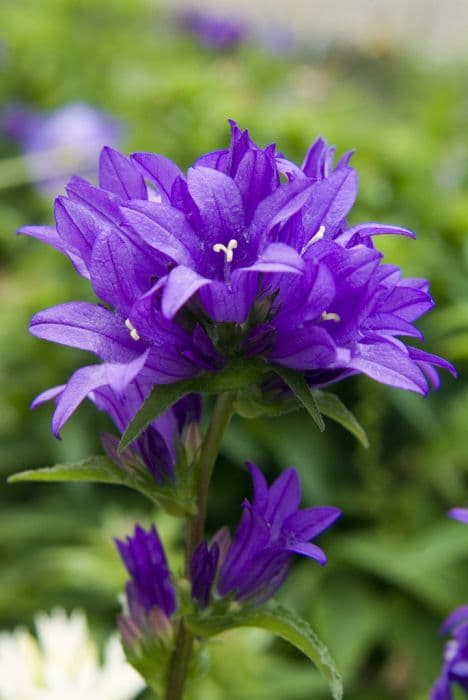Peach-leaved Bellflower Campanula persicifolia 'Fleur de Neige' (d)

ABOUT
The plant known as 'Fleur de Neige', which translates to 'Snowflake', is a beautiful flowering perennial that boasts a refined appearance. It features a basal rosette of dark green, lance-shaped leaves that present a stark contrast against its delicate flowers. The leaves are smooth and have a glossy sheen, creating a lush carpet at the base of the plant. The most striking feature of 'Fleur de Neige' is its bell-shaped flowers, which are pristine white, resembling a dusting of snowflakes. These blooms are arranged gracefully on upright, slender stems which rise above the foliage, giving an airy and elegant display. The petals of the flowers are broad with a slight flare at the edges, creating a star-like shape when viewed from above. Each flower boasts a slight cupped form, which adds depth and showcases the intricate details of the inner flower structures. The inside of the bells often has visible delicate veins, adding to their charm. Blooming typically occurs during the late spring to early summer, providing a refreshing burst of color in the garden. 'Fleur de Neige' tends to form clumps as it grows, with the flower stems emerging from the center of the leafy base. It gives an impression of both tidiness and abundance, making it a popular choice for gardeners who wish to create a serene and picturesque landscape. The contrast between the cool-toned, snow-white flowers and the warm, lush green foliage is visually striking and gives this plant a romantic yet crisp aesthetic.
About this plant
 Names
NamesFamily
Campanulaceae
Synonyms
Peach-Leaved Bellflower, Fairy Bellflower, White Bellflower, Willow Bellflower
Common names
Campanula persicifolia 'Fleur de Neige'.
 Toxicity
ToxicityTo humans
Peach-leaved bellflower is generally considered non-toxic to humans. There are no well-known toxic effects or symptoms of poisoning from ingesting this plant.
To pets
Peach-leaved bellflower is also generally considered non-toxic to pets. It is not known to cause any significant toxicity or symptoms of poisoning if pets ingest parts of this plant. However, as with any non-food plant, it is always possible for individual animals to have a sensitivity or allergic reaction, so it is still wise to prevent pets from consuming plants not meant for their diet.
 Characteristics
CharacteristicsLife cycle
Perennials
Foliage type
Deciduous
Color of leaves
Green
Flower color
White
Height
2-3 feet (60-90 cm)
Spread
1-2 feet (30-60 cm)
Plant type
Herb
Hardiness zones
3-8
Native area
Europe
Benefits
 General Benefits
General Benefits- Attracts Pollinators: The bell-shaped flowers of 'Fleur de Neige' provide nectar for bees, butterflies, and other beneficial insects.
- Low Maintenance: 'Fleur de Neige' is a hardy plant that requires minimal care, making it ideal for busy gardeners.
- Long Blooming Period: The plant is known for its long flowering season, offering white blooms from late spring to early summer.
- Aesthetic Appeal: With its elegant white flowers and foliage, it adds beauty to garden borders and flower beds.
- Drought Tolerant: Once established, 'Fleur de Neige' can tolerate periods of drought, making it suitable for drier climates.
- Cold Hardy: It is capable of surviving in colder climates, which makes it a robust choice for various gardens.
- Groundcover: Its growth habit can provide ground coverage, which helps prevent weeds and soil erosion.
 Medical Properties
Medical PropertiesThis plant is not used for medical purposes.
 Air-purifying Qualities
Air-purifying QualitiesThis plant is not specifically known for air purifying qualities.
 Other Uses
Other Uses- The flowers of Peach-leaved Bellflower can be used in mixed bouquets, providing a delicate and elegant touch to floral arrangements with their pristine white color.
- The stalks of this plant have been used traditionally in floral crowns for festive occasions or weddings, giving a natural and rustic charm to the headpieces.
- Peach-leaved Bellflower can be an educational plant for children, showing them how to care for a living organism and to observe the lifecycle of a plant from germination to flowering.
- The dried flowers can be used in crafting, such as in homemade paper making, to create a unique texture and visual appeal with the embedded petals.
- Leaves of the plant can be used in art projects, such as leaf printing or stamping, where their shape and texture provide interesting patterns.
- Photographers sometimes use Peach-leaved Bellflower in macro photography to practice capturing the subtleties of color and form in nature.
- The plant can be used to create a living fence or border in a fairy garden, adding a touch of magic to miniature landscapes.
- Peach-leaved Bellflower petals can be gently pressed into books or diaries, creating natural bookmarks or decorative additions to the pages.
- Hobbyist ice cream makers sometimes use the blooms to infuse a floral note into homemade ice creams or sorbets, although this is not a widely recognized culinary use.
- In textile dyeing, the flowers have occasionally been used to achieve a light blue dye, although the color yield is variable and not extensively documented.
Interesting Facts
 Feng Shui
Feng ShuiThe Peach-Leaved Bellflower is not used in Feng Shui practice.
 Zodiac Sign Compitability
Zodiac Sign CompitabilityThe Peach-Leaved Bellflower is not used in astrology practice.
 Plant Symbolism
Plant Symbolism- Constancy and Perseverance: Also known as Peach-leaved bellflower, Campanula persicifolia 'Fleur de Neige' often symbolizes unwavering faith and constancy due to its characteristic bell shape, which is steadfast and unchanging.
- Gratitude: The bellflower is associated with feelings of thankfulness. Its habit of blooming abundantly can be seen as a symbol of generosity and giving thanks.
- Vulnerability and Love: With its delicate appearance, the Peach-leaved bellflower also represents vulnerability and the idea that love can be beautiful and fragile, requiring gentle care to thrive.
- Everlasting Love: Its long blooming period and tenacious growth habit suggest enduring love, making it a favorite for expressing long-term commitment and affection.
 Water
WaterThe Peach-leaved Bellflower should be watered deeply once a week, and the soil should be allowed to dry out slightly between waterings. Apply water directly to the base of the plant to keep moisture off the foliage and prevent disease. Use approximately one gallon of water for each plant during each watering session, ensuring that the water penetrates deeply into the soil to encourage strong root development. During the hotter, drier months, watering frequency may increase to twice a week. In contrast, during cooler or rainy periods, reduce the amount of water accordingly to avoid waterlogging the soil.
 Light
LightThe Peach-leaved Bellflower thrives in a location that receives full sun to partial shade. Ensure the plant gets at least six hours of sunlight each day for optimal growth. However, in hotter climates, some afternoon shade will help protect the plant from intense heat. The ideal spot would protect the plant from harsh midday sun while still providing a good amount of morning sunlight and dappled afternoon light.
 Temperature
TemperaturePeach-leaved Bellflower prefers a temperate climate with temperatures ranging from 40 to 85 degrees Fahrenheit. It can tolerate occasional dips below freezing but isn't suited for extremes of heat or cold. The ideal temperature range for this plant's robust growth and flowering is between 60 and 75 degrees Fahrenheit. While it's fairly hardy, prolonged exposure to temperatures over 90 degrees Fahrenheit may stress the plant.
 Pruning
PruningPruning is essential for Peach-leaved Bellflower to remove spent flowers and encourage a second bloom. Deadheading, or cutting off the faded blooms, can be done throughout the flowering season. At the end of the blooming period, cut back the flower stalks to the base to tidy the plant and promote healthy growth for the next season. The best time for a major prune is in late winter or early spring, before new growth starts.
 Cleaning
CleaningAs needed
 Soil
SoilPeach-leaved bellflower thrives in well-draining soil rich in organic matter with a pH range of 6.0 to 8.0. A mix of loamy soil, compost, and perlite or sand to enhance drainage would be ideal for this plant.
 Repotting
RepottingPeach-leaved bellflower typically does not require frequent repotting and can be repotted every 2-3 years or when it outgrows its current container.
 Humidity & Misting
Humidity & MistingPeach-leaved bellflower prefers a moderate humidity level but is quite adaptable and can tolerate the humidity levels typically found in most home environments.
 Suitable locations
Suitable locationsIndoor
Provide bright indirect light, cool temperatures, and regular watering.
Outdoor
Plant in partial shade, ensure well-drained soil, and water regularly.
Hardiness zone
3-8 USDA
 Life cycle
Life cycleCampanula persicifolia 'Fleur de Neige', also known as Peach-leaved Bellflower, initiates its life cycle as a seed, which upon germination develops a small rosette of basal leaves, often in the cool temperatures of spring. As the plant matures, it sends up erect, leafy stems during late spring or early summer, depending on the climate. The plant reaches the flowering stage in early to mid-summer, producing its white, bell-shaped flowers that are attractive to bees and other pollinators. After pollination, the flowers develop into seed capsules, and by late summer or fall, the seeds are dispersed, allowing for self-seeding if conditions permit. During the winter, the plant may die back, especially in colder climates, but being a perennial, its root system remains alive and it will regrow from the base the following spring. The plant continues its life cycle by undergoing these stages year after year, with clumps enlarging over time as it spreads slowly by rhizomes.
 Propogation
PropogationPropogation time
Spring to Summer
Campanula persicifolia 'Fleur de Neige', commonly known as the Peach-leaved Bellflower, is typically propagated by division or by sowing seeds. The most popular method of propagation for this perennial is division, which is best done in the spring or early fall. To propagate by division, carefully dig up the plant and gently separate the clumps into smaller sections, ensuring that each section has a good amount of roots. Replant these divisions at the same depth they were growing at previously, spacing them about 12 to 18 inches (30 to 45 centimeters) apart to allow for growth. Water the newly planted divisions thoroughly to help establish them. This method is effective because it helps rejuvenate older plants and increases the number of plants in your garden at no extra cost.









